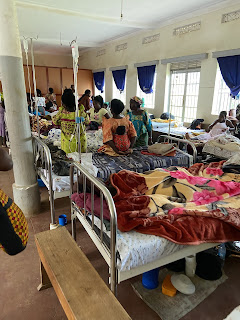Study Theme: Nutrition
Malnutrition: In a Land Plentiful of Food?
By: Nicolas Cruz, Flavia Nalugya, Veena Thamilselvan
In a country plentiful with food and subsistence farming, it is surprising to find that many children suffer from malnutrition. After visiting different hospitals and living with a homestay family in Rakai, we have come to build upon our knowledge of nutritional intake in rural and urban communities, along with administrative and cultural factors that affect malnutrition.
During our time at Kalisizo Hospital, we had the opportunity to meet a nutritionist who educated us about the several barriers that prevent Ugandans from properly eating healthy and nutritious foods, these include: economic, cultural, and regional difficulties. Firstly, the nutritionist illustrated that eating healthy foods and having a balanced diet is not a priority of most citizens. She explained that the optimal diet in Uganda includes: a protein, carbohydrate, and vegetables. A sample meal of this is matooke, ground nuts, and fresh beans. The nutritionist stated that although many families grow their own food, they often sell off the produce instead of consuming it leading to inadequate food supply.
In terms of cultural norms, it is a common norm that the father, or head of the household, makes decisions in regards to the family’s diet. Although the mother shops for groceries at the nearby market and can advise the husband on what foods the family needs, the husband has the final decision on what food stuffs are purchased. Once the food is prepared the head of the household receives the largest portion of quality food, while the mother and children receive less nutritious portions. In certain households it is believed that women should not eat chicken or eggs, so they are not permitted to eat such food. The nutritionist stated that the Kalisizo Hospital previously participated in several government sponsored programs, such as UNAP (Uganda Nutrition Action Program), that were used to identify and support malnutrition cases along with educational campaigns. Sadly, due to budget cuts and lack of funding these programs were terminated.
At Mulago hospital, there is a nutrition unit called Mwana Mugimu which admits patients with severe complications of nutrition who are referred there from the paediatric ward. After admittance, mothers and their children are taken to triage where the history of both the mother and the baby is taken. Nurses also complete a systematic checkup of the baby where they check for severe anemia, vitamin A deficiency, tuberculosis, HIV, dermatosis, fever, and infection. If any of these illnesses are found positive they are put on immediate antibiotics and supportive care. Since health education is a key part of the elimination of malnutrition among children, hospital staff educate them about hygiene for their babies, exclusive breast feeding, and nutritious cooking methods. Mothers are told to always prepare both animal and plant protein for the baby and to use their hands to measure the correct amount. Nurses also help women learn different skills like tailoring, baking, and arts and crafts to earn a living when they go back to the community. Babies go through two phases for rehabilitation. In phase one, babies start taking F-75 therapeutic milk to regain appetite along with drinking breast milk. Phase two is where solid food is introduced to the babies. In order to go to phase two, babies must pass what nurses call an acceptance test which is to see if babies are gaining weight and able to consume RUTF (Ready to Use Therapeutic Food), a nut flavored paste, to help get more nutrients. Nurses face challenges when mothers dodge check-ups to continue using hospital space and resources even when their child responds positively to treatment.
 |
| Families are provided, free of charge, tins of F-75, F-100, and RUTF at the Mwana Mugimu Unit to provide calories and nutrients to their malnourished children |
Reflecting back, we learned that at the national level, lack of funding was a key impediment in providing nutrient supplements, training nutritionists, and creating village health teams to reach out to families. Although we are well aware that numerous NGOs could provide this monetary support, we believe that more funding should be allocated through the government budget to encourage prioritization of these issues and inter-ministry cooperation. At the local level, we learned that families using subsistence farming should also practice food preservation to protect against market instabilities.
 |
| A homestay meal we received consisting of Irish potatoes, carrots, rice, and fish in broth. |




Comments
Post a Comment